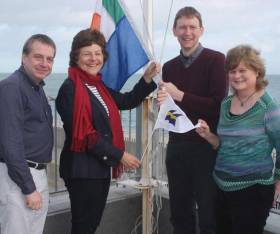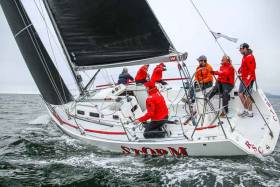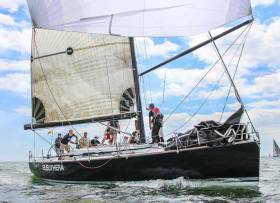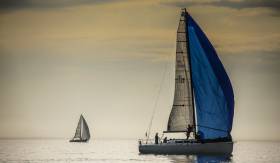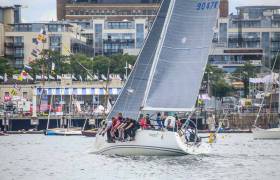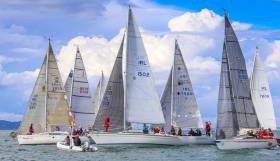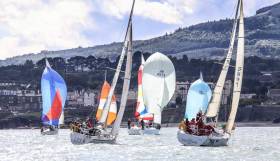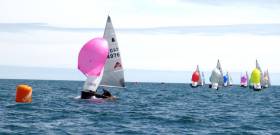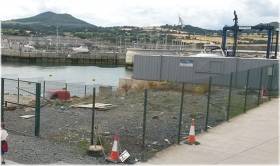Displaying items by tag: Greystones Harbour
Major Sailing Events to Bring Welcome Tourism Revenue to Greystones
Speaking at the Clubs 2019 launch, the incoming Greystones Sailing Club Commodore, Daphne Hoolahan, said that “2019 is looking like a busy year.
Greystones Sailing Club is honoured to be hosting the Wayfarer World Championships in July and we expect over 100 boats with up to 250 guests from around the world to take part in this week-long event. Already we have entries from Denmark, Holland, France, UK, Cyprus, the USA, Canada and South Africa. It will showcase Greystones yet again, as a landmark sailing centre on the East Coast of Ireland. As well as this, the RS Eastern Championships will kick off the season in April and we will also host, yet again, the annual Taste of Greystones Regatta in August, which brings in over 500 sailors in over 100 keel boats to Greystones Harbour Marina on an annual basis, bringing welcome tourism revenue to the town.”
“Greystones Sailing Club has an active training and sailing program, providing sailing instruction to both children and adults and is open for membership. Everyone is encouraged to try sailing on our many adult or child courses, and we welcome new members to contact us, to be part of this growing, vibrant club,” Daphne added.
The Club has over 300 members sailing a variety of dinghy classes and offers exciting and enjoyable dinghy racing for all ages and abilities. It has a well-earned reputation as one of the top dinghy sailing clubs in Ireland with its sailors competing successfully in many open events over the years, both nationally and internationally. The Club also boasts an active and growing keelboat fleet with over 30 keelboats giving competitive racing on a twice weekly basis.
Greystones Sailing Club Regatta drew a fleet of over 80 boats for its annual regatta today. Despite the wet and windy forecast, the popular end–of–season fixture drew boats from clubs as far north as Malahide in County Dublin and as far south as Arklow in County Wicklow but by far and away the biggest visiting contingent were from Dublin Bay with nearly half the regatta fleet coming from Dun Laoghaire.
Today's two-race regatta was preceded on Saturday by feeder races by ISORA and DBSC. The ISORA race was won by Chris Power Smith's J122 Aurelia, report here. The DBSC race results are here.
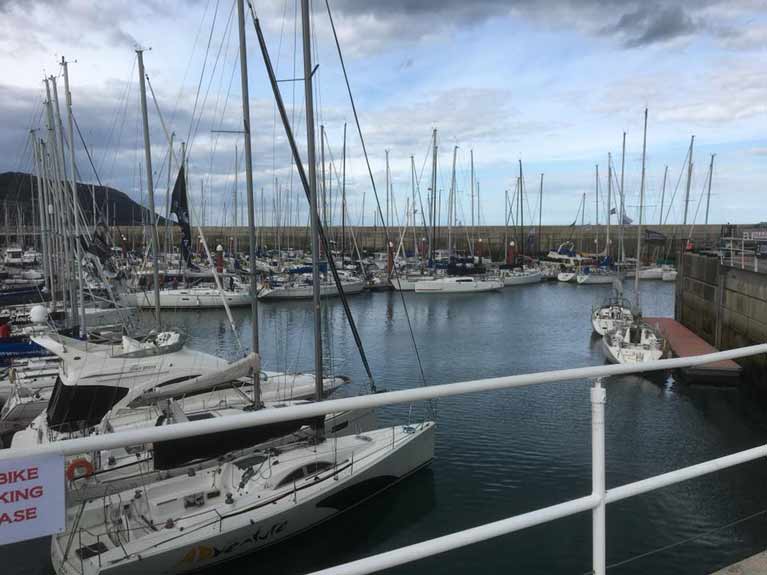 Greystones Harbour Marina packs in the visiting boats for the annual 'Taste of Greystones' Regatta Photo: Afloat.ie
Greystones Harbour Marina packs in the visiting boats for the annual 'Taste of Greystones' Regatta Photo: Afloat.ie
Although Greystones Harbour's embryonic 16–boat cruiser fleet did not manage to win any of the regatta's five divisions, GSC boats were on the podium in classes one, two and the white sails division.
After a one hour postponement, conditions were light for race one with winds from zero to 15 km/h but breezier for race two with wind speeds increasing to 20 to 35km/h.
Howth's Storm Continues Class One Wins
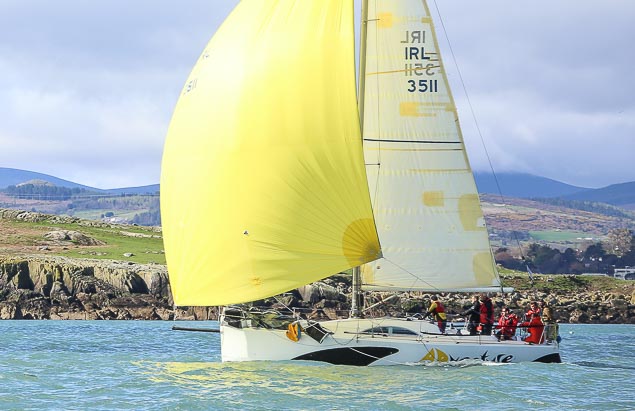 Daragh Cafferkey's Another Adventure (above) was third and fellow GSC competitor Eleuthera (below) was fourth Photos: Afloat.ie
Daragh Cafferkey's Another Adventure (above) was third and fellow GSC competitor Eleuthera (below) was fourth Photos: Afloat.ie
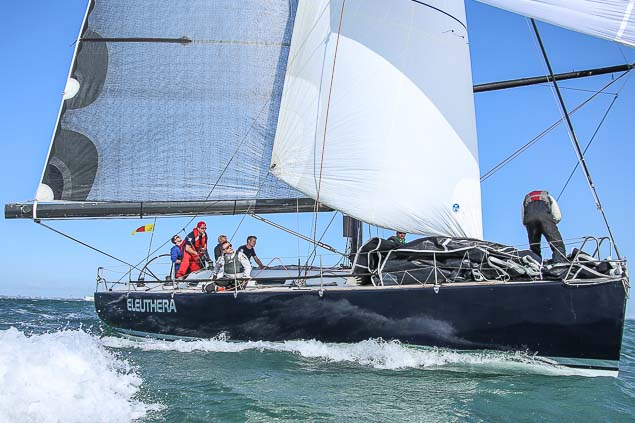
One of the biggest class one turnouts of the season featured three entries from the host club, including the hotly tipped Grand Soleil 44 Eleuthera skippered by Frank Whelan. But in a continuation of a season of successes for Howth Yacht Club J109 Storm, the Kelly family boat now adds the Taste of Greystones title too with two race wins today, just a week after being awarded the inaugural Celtic Cup for her season's long exploits across the Irish Sea Race area. Second to Storm was another J109, Tim Goodbody's White Mischief from the Royal Irish Yacht Club while Greystones own A35 Another Adventure (Daragh Cafferkey) was third overall.
Keating's Checkmate Wins Class Two
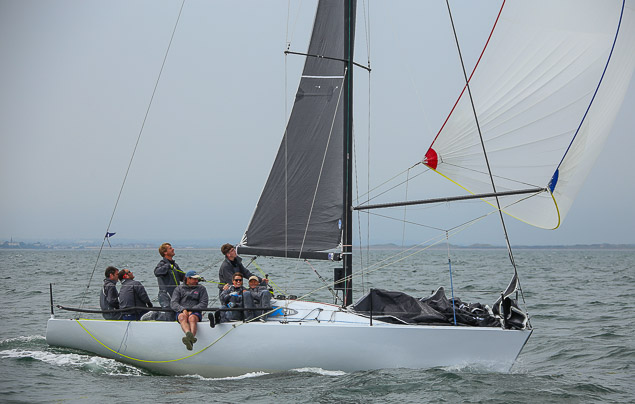 Half Tonner Checkmate XVIII competed in Greystones Photo: Afloat.ie
Half Tonner Checkmate XVIII competed in Greystones Photo: Afloat.ie
Howth Half Tonner Checkmate (not that one) was the winner of the ten boat Cruisers 2 fleet with Boomerang (James Kirwan) second. The Half Tonner competing in Greystones was Checkmate XVIII, the Nigel Biggs restored half-tonner entered for the Wicklow Regatta by Ross Keating.
Third was Greystones Sailing Club's own 'Virgin Triangle' skippered by Graham Noonan.
Running Wild Wins Class Three
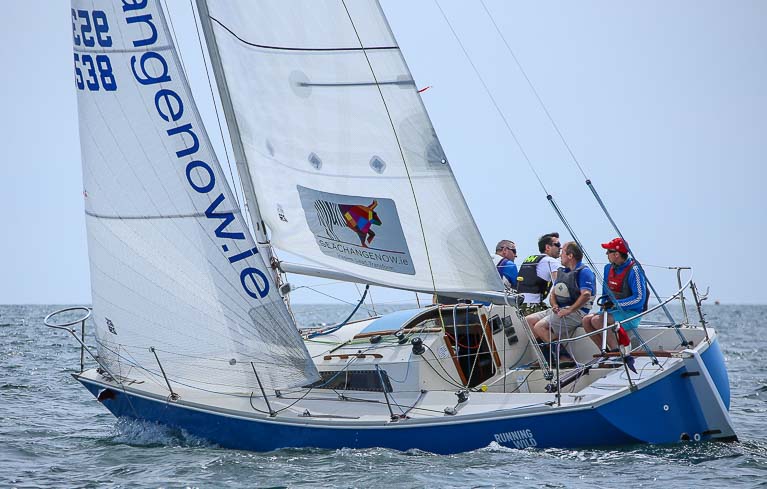 Brendan Foley's Impala, Running Wild Photo: Afloat.ie
Brendan Foley's Impala, Running Wild Photo: Afloat.ie
In Cruisers 3, the biggest fleet of the BJ Marine sponsored regatta with 22 boats, Brendan Foley's Impala Running Wild from the Royal St. George Yacht Club, was the clear winner with two first places from Barry Cunningham's Quarter Tonner Quest of the Royal Irish Yacht Club. Third was Luke Fegan's Hustler 32, Smokehaze from Malahide Yacht Club.
Full results are downloadable below
Large Dublin Bay & ISORA Fleets Heading for Greystones Regatta
The buoyant Dublin yacht racing scene moves en masse to County Wicklow this weekend as two of the country's leading yacht racing organisations prepare separate feeder races for the Taste of Greystones Regatta on Sunday afternoon.
A 25–boat ISORA fleet will have a feeder race starting at 10.00 on Saturday morning from Dun Laoghaire as one of the final races of the offshore season.
And from 12.45 on Saturday, Dublin Bay Sailing Club (DBSC) feeder races to the County Wicklow port will also be sailed.
For participating DBSC classes namely, Cruisers 1, Cruisers 3 and Cruisers 5, the race south – that could see as many as 50 DBSC yachts competing – replaces the regular DBSC fixed-mark courses scheduled for this date.
The Greystones results will also count for DBSC Saturday Series 2 (ECHO, IRC and scratch where applicable).
On Sunday, the combined fleets with assorted other boats from the East coast will compete in two ECHO handicap races in the 'Taste of Greystones Regatta' sponsored by BJ Marine.
A target time of 14:30 for completion of two race series has been set and prize giving is targeted for 15:30 to allow visiting boats reasonable departure time. Only one race is required to be completed to constitute a series.
The entry fee for all Classes is €75.00 and this includes a free marina berth on Saturday night, a complimentary drink voucher at the sailing club and Beach House Pub plus a free Breakfast on Sunday morning before racing!
Download both the Regatta Notice of Race and the DBSC Feeder Race Course Card below
Five Dublin Bay Sailing Club Classes Racing To Greystones Regatta
Dublin Bay Sailing Club (DBSC) has organised feeder races over a specially designed course to Greystones Regatta (preview here) on Saturday, August 26th for five of its participating classes.
Cruisers 1, Cruisers 2, Cruisers 3, B211s and Cruisers 5 are all racing to the County Wicklow Regatta instead of the regular DBSC fixed–mark courses originally scheduled.
The DBSC boats are part of a wider fleet of boats leaving the Bay for the end–of–season afffair in Wicklow that includes a 27-boat ISORA fleet.
Like ISORA, DBSC has anticipated light winds for the race and Courses may be shortened by a committee boat (or RIB) displaying Flag S taking up position at one of the course locations (see below).
Feeder Race results will count for DBSC Saturday Series 2 (ECHO, IRC and scratch where applicable).
This weekend's East Coast Cruisers Three Championships is using both Saturday's DBSC Feeder Races and the Greystones Regatta to form its championship Series.
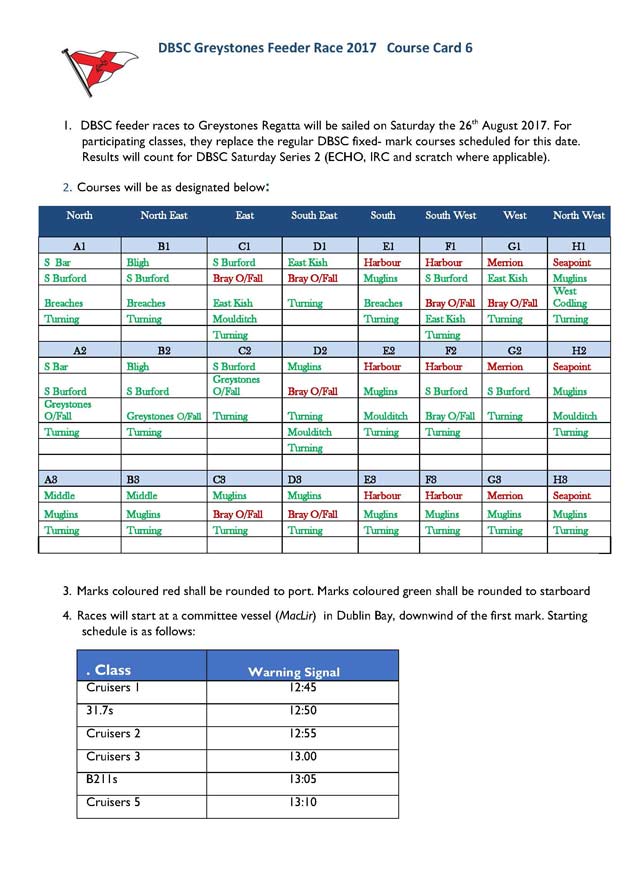 DBSC's specially designed 'Course Card 6' for feeder racing to Greystones Regatta. Download course card PDF below.
DBSC's specially designed 'Course Card 6' for feeder racing to Greystones Regatta. Download course card PDF below.
27 ISORA Boats Expecting Light Wind Race to Greystones
A confirmed fleet of 27–boats in the ISORA day race from Dun Laoghaire in County Dublin tomorrow will most likely race south to Greystones Harbour in County Wicklow in light westerly winds.
The race is the deciding race in the Viking Marine Coastal Series and the Royal Alfred Coastal Series.
ISORA chiefs are preparing for the possibility of fickle winds under Bray Head by posting a revision to sailing instructions (downloadable below). The final course to be sailed will not be selected until later this afternoon.
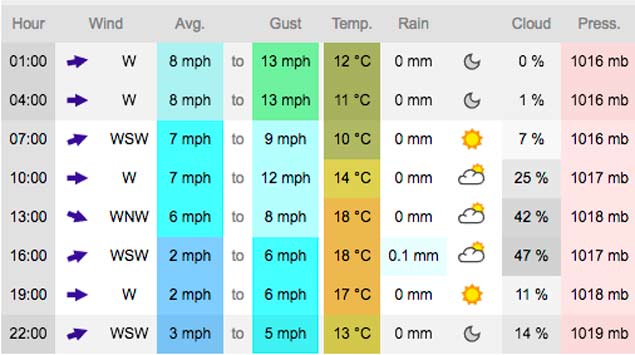 Light winds are forecast for the weekend off the east coast of Ireland
Light winds are forecast for the weekend off the east coast of Ireland
The warning signal for the burgeoning offshore fleet will sound off Dun Laoghaire Harbour tomorrow at 0955 for the 12–mile coastal race.
Organisers are emphasising that the finish line will not be the Gresystones yellow buoy but a co–ordinate immediately south of the stated position of that buoy.
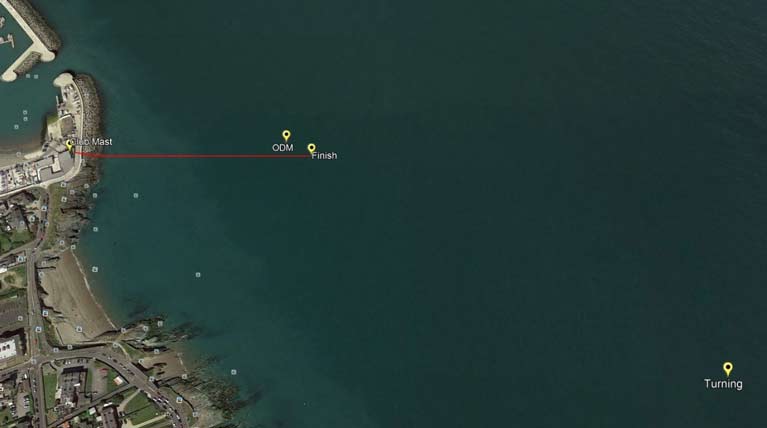 The ISORA finish line at Greystones is a coord immediately south of the stated position of that buoy
The ISORA finish line at Greystones is a coord immediately south of the stated position of that buoy
It is anticipated onboard trackers on each of the competing boats will record the finish time.
The fleet will raft up at Greystones Marina afterwards and compete in Sunday's two race Taste of Greystones Regatta, preview here.
The East Coast Championship for Cruisers Three takes place this weekend with an 'innovative mix of racing' using the DBSC Saturday feeder race from Dun Laoghaire to Greystones and combining this race with two races on Sunday as part of the 'Taste of Greystones' Regatta.
Read the Greystones Regatta preview here.
NOR is available from Michael Ryan at [email protected]
East Coast sailing fans are expecting a big weekend for the 'Taste of Greystones' Regatta this Sunday and, as the name suggests, Greystones Regatta in County Wicklow is about a night–out followed by a morning's racing. 'The night out is guaranteed, says Greystones Sailing Club Commodore, Darragh Cafferkey, 'the racing now lies with the wind gods'.
'All this week the weather forecasts have been bouncing from five to 25–knots and from factor 50 to umbrellas', Cafferkey told Afloat.ie
It must surely be a case of third time lucky for the Wicklow initiative because the last two editions have been cut short due to lack of wind.
As Afloat.ie reported earlier this week, 55 boats are already entered – and that's ahead of 2016 numbers at this stage – to the extent that Cafferkey, himself a top Irish Sea Offshore campaigner, estimates 140 boats are expected for the raft–up at Greystones Marina in preparation for the two race series on Sunday morning that marks the end of the Summer sailing season on the East coast.
In 2013, the inaugural regatta attracted 68 boats, in 2014, this had grown to 80 and in 2015 the regatta broke the 100–mark with 2016 witnessing further growth.
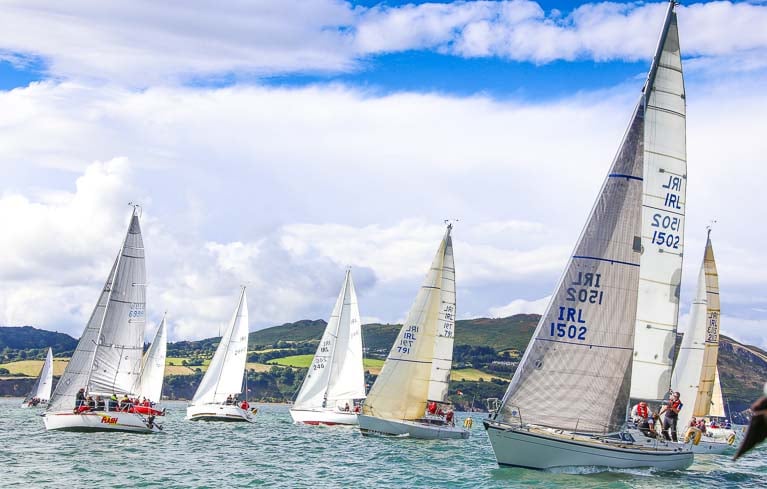 Cruiser–racers will race on two separate courses this year at the Taste of Greystones Regatta in County Wicklow Photo: Afloat.ie
Cruiser–racers will race on two separate courses this year at the Taste of Greystones Regatta in County Wicklow Photo: Afloat.ie
This year the event will be split into two courses with Class 1, 2, 3 racing on North course and White Sails in two fleets on South Course.
As Afloat.ie reported in August 2013, the regatta was originally established in a format that would attract all the East Coast clubs that don’t typically travel, it has grown in size with the following clubs all confirming feeder races.
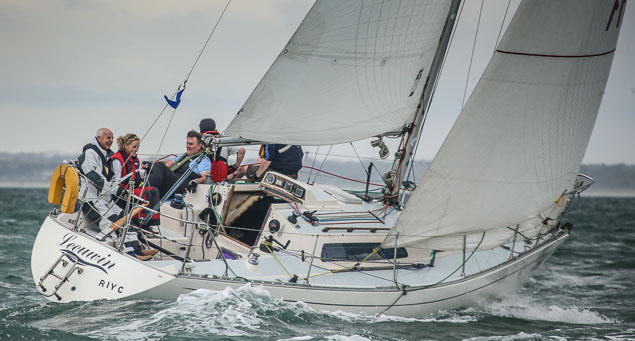 Dublin Bay's Bobby Kerr is a past competitor at Greystones sailing his Sigma 33 Leeuwin from the Royal Irish Yacht Club. Photo: Afloat.ie
Dublin Bay's Bobby Kerr is a past competitor at Greystones sailing his Sigma 33 Leeuwin from the Royal Irish Yacht Club. Photo: Afloat.ie
Wexford/Courtown will race to Arklow and join the Arklow fleet for a race to Greystones Harbour.
Wicklow Sailing Club, Bray Sailing Club, Poolbeg Yacht and Boat Club and Clontarf Yacht and Boat Club have all confirmed races to Greystones on Saturday, Caffekey told Afloat.ie
Dublin Bay will have a feeder race available for all classes and ISORA have over 25 entries confirmed for its race to Greystones.
Over ten boats from Howth have also entered meaning almost every club on the East coast plan to attend.
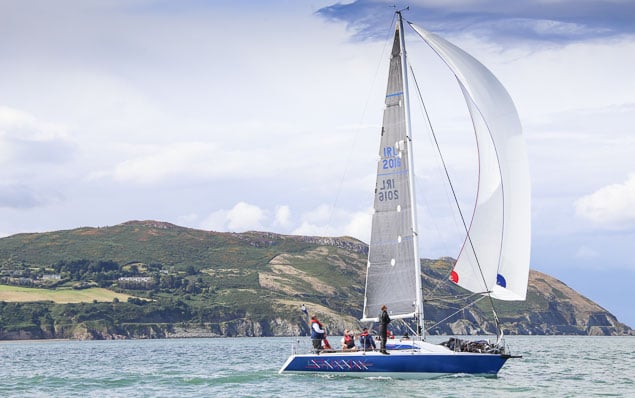 Dave Cullen's champion Checkmate is a regular competitor off Wicklow Photo: Afloat.ie
Dave Cullen's champion Checkmate is a regular competitor off Wicklow Photo: Afloat.ie
A feature of the event is that it is run both on IRC/Standard ECHO and current ECHO. IRC/Standard Echo with only a few points between them means all boats regardless of certs can race based on the boat' s rating, according to Cafferkey.
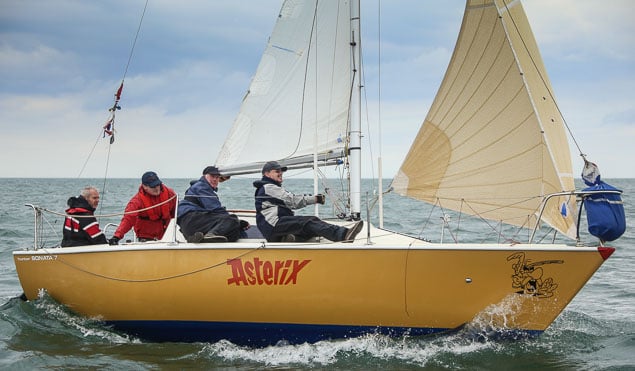 Frazer Meredith's Astrix, a Hunter Sonata, is heading for Greystones Photo: Afloat.ie
Frazer Meredith's Astrix, a Hunter Sonata, is heading for Greystones Photo: Afloat.ie
The current Echo means that the many non Dublin Bay clubs can use their own local ratings to come to a joint event . There is a limit on current echo to 3%+/- the boats standard handicap.
It is this decision four years ago that made it realistic for all East Coast clubs to come and compete. 'So prizes based on your boat and prizes based on your club performance. Something for everybody', Cafferkey says.
The support of sponsor BJ Marine has allowed Greystones Sailing Club organisers extend hospitality at its new club house that opened over a year ago on the South Pier, to include berth, BBQ, beer in Club and Beachouse plus Breakfast on Sunday. 'Throw in some Musto discounts, Water, bars and sandwiches on the water and there is little left uncovered', Cafferkey says.
First gun at Greystones on Sunday is at 10.55am.
The Purcell Trophey 2017 was hosted by Greystones Sailing Club in their east coast new harbour and clubhouse at County Wicklow. After an hours wait on Saturday morning for the mist to clear the 26–strong GP14 fleet finally launched.
Race 1 got underway with a clean start and no recall (unusual in this fleet). Ger Owens & Mel Morris were back in business with a win, Shane McCarthy & Damian Bracken taking second with Alan Blay & David Johnston in third.
Race 2 started with the wind starting to build. Shane and Damian took the win with Ger & Mel in second and John & Donal McGuiness in third.
Race 3 started with gusts of winds of 26–knots. Alan & David retired with gear failure. Ger & Mel continued to dominate and brought home their second win for the day. Shane & Damian picked up an OCD so Colman Grimes & Eoin Boyle came home in second with Alistar Duffin & Andy Corkhill in third.
Race 4 started on Sunday morning with lighter winds and sunshine, Ger & Mel once again on form with another win and Alan & David with their boat repaired took 2nd just ahead of Shane & Damian in 3rd.
Race 5 was a closely fought battle between Ger & Mel and Shane & Damian with Ger & Mel winning and Shane & Damian close behind in 2nd. Simon Culley & Libby Tierney pulled off a fantastic move on the downward leg by going close to the shore and took 3rd place.
Race 6 was cancelled as the wind died.
So the gold fleet was won by Ger & Mel.
The silver fleet was dominated by the Gallagher brothers, sailing well once again.
The bronze fleet was won by Josh Porter & Sina Hartman in their first event.
Results downloadable below.
Newbuild Car-Ferry Makes Historic Call to Greystones Harbour
#HistoricCall – The first ever car-ferry to visit Greystones Harbour, Co. Wicklow made history when the Spirit of Rathlin carried out berthing vehicle-loading trials yesterday, writes Jehan Ashmore.
Spirit of Rathlin, a £2.8m ferry which was only launched last Autumn in Arklow is from where the vessel took the short passage to Greystones Harbour. It's arrival was very much a surprise for a handful of curious onlookers who witnessed the entry of the vessel between the circular pierheads.
The presence of a large commercial vessel added to the novelty factor, given the context of the leisure harbour with its 100-berth marina which occupies the inner harbour.
It was within the outer harbour where the 28m long Spirit of Rathlin berthed at the slipway. Soon after arrival the ramp of the bow-only loading ferry was lowered onto the slipway's concrete surface from where the first vehicle was driven in reverse on board. The red-painted vehicle deck is designed to carry six vehicles.
Spirit of Rathlin’s call to Greystones was due to the harbour's proximity and use of a suitable slipway to conduct such vehicle trials of the 140 passenger ferry. This also involved the testing of loading a van belonging to the newbuild’s boatyard of Arklow Marine Services.
In all the call to Greystones was brief, as the blue-hulled newbuild departed just over an hour later to return to Arklow and berth at the North Quay, where AMS have their boatyard.
The Belfast-registered newbuild was contracted to AMS from Northern Ireland’s Department for Infrastructure. The DFI carried out a tendering process of a new 10 year tender contract to operate Spirit of Rathlin on the Ballyscastle-Rathlin Island service. The tender was awarded to Rathlin Island Ferry Ltd.
Spirit of Rathlin will enter service once works costing £1m to accommodate the new ferry at the mainland Co. Antrim harbour is completed.
The newbuild will replace the current car-ferry Canna. A second passenger-only craft, Rathlin Express also built by the same Arklow yard in 2009 will remain in service.
New Greystones Coastguard Station 'Not Viable'
The new Coastguard station at Greystones harbour will not be built, according to Wicklow Councillor Derek Mitchell who says that after 12 years of discussions, planning and building at the harbour the Coastguard has decided to pull out.
The Coastguard have told Wicklow County Council that ‘it is deemed no longer viable to pursue the development at this site due to lack of funding in meeting the requirements’, Councillor Mitchell told Afloat.ie
‘I am very annoyed the Coastguard say it is not viable to build the station at this site in Greystones. The Council has given them a valuable site specially constructed on the new pier and built a special slipway for them. It is incredible that after 12 years discussions, planning and building the harbour they pull out' he said.
Councillor Mitchell also said 'I gather that the problem is that the building is costly because the site will be subject to storm waves, however the Greystones Sailing Club and four other clubs have been constructed with this in mind. They should put the boat on the calm marina and build a simpler less costly building. To my mind getting the boat going is much easier and safer from the marina than slip launching from the outer basin which can be rough in easterly winds’.


























